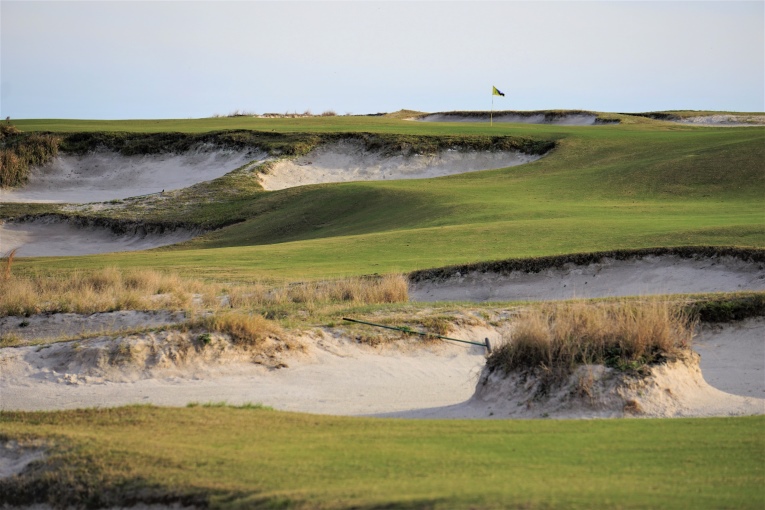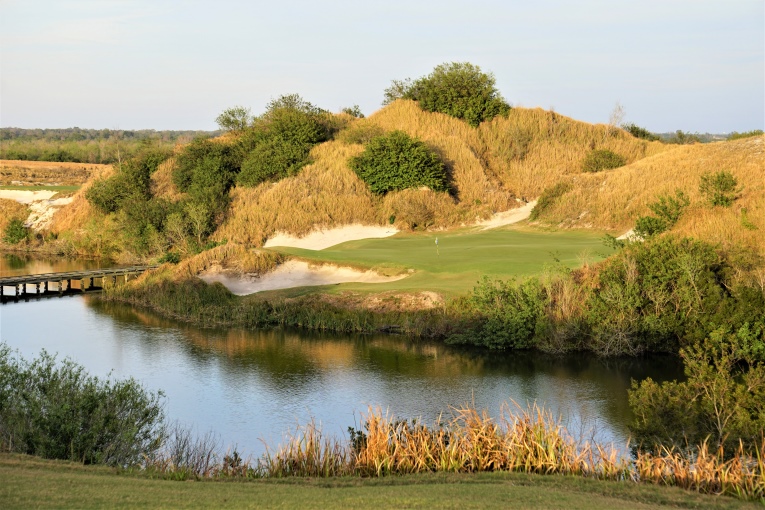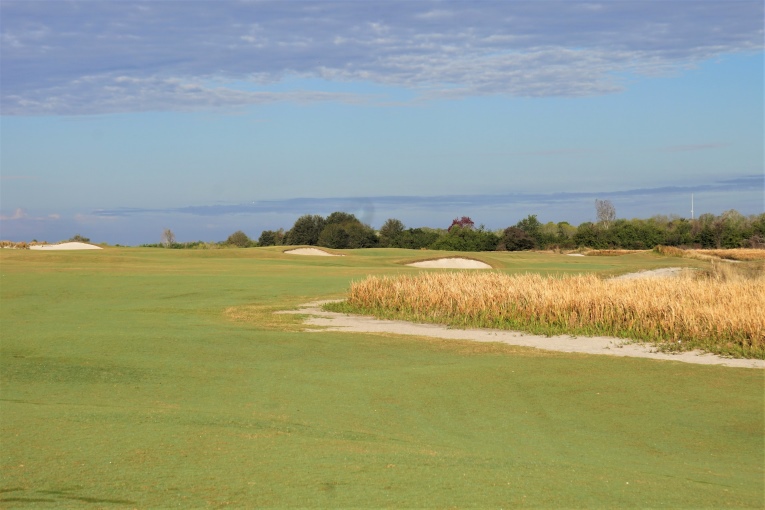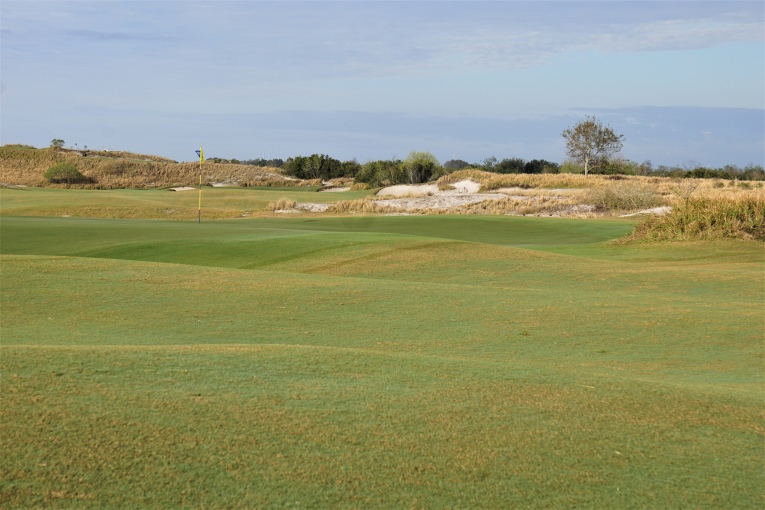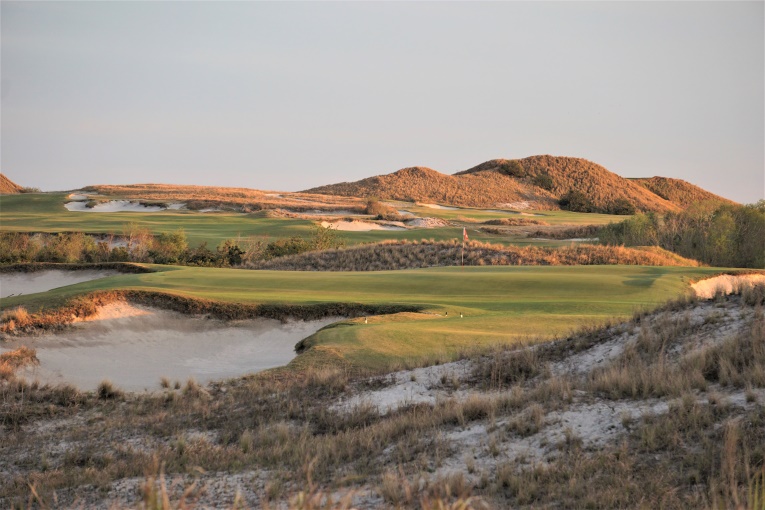Streamsong Blue
Florida, United States of America
Until Streamsong, no resort has ever featured multiple courses where players were equally torn as to their favorite. If ten golfers were asked, three would respond that the Black Course is their favorite, three Red, and three Blue. The deciding tenth vote could go any way. What a dream scenario for a resort! Some might say Bandon pulled off a similar feat and while Bandon Trails is the author’s favorite course, he understands that he’s in a minority. Pinehurst came close in the mid 1930s but No. 4 never quite achieved the popularity of No. 2 or No. 3.
How did Streamsong manage it? The visionary for its creation is Richard Mack of the Mosaic Corporation, which had been mining for decades 16,000 acres in Polk County, Florida for phosphate. By law, the company was required to remediate the land and certainly, Mosaic could have returned it to a series of deep water fishing holes and walking trails. However, the drawback to that environmentally friendly approach was that it would have meant a minimal economic impact for the area. Instead, Mack lobbied internally to develop a golf resort that ticked both boxes by paying tribute to the landscape and creating a tax base for the county. Today, over 500 people are employed by the resort, many of whom drive nearly one hour to work.
Its path to success seems straightforward: offer 16,000 acres to the two premier architects of the past thirty years to build courses without an allowance for homes. Initially, Bill Coore did a preliminary 18 hole routing on what he determined to be the best land. He found playing corridors that largely became Red 7, 9, 14-18 and Blue 3-6, 8 and 15 as well as bits of other holes. Because the property is enticingly removed from a population center, Mack was adamant that it be a 36 hole resort. Visitors needed to not only play but spend the night, eat, and drink to make the resort financially viable. So, it became Tom Doak’s turn to peruse the vast acreage. He concurred that Coore had identified the superior topography, soil and features. The question became: could the identified area support 36 holes? The two architects fanned out and found what would become Red 10-13 and Blue 9-11. Subsequently, recently mined land was designated Red 2-4. Ultimately, the two architects became convinced that two courses of comparable quality could emerge.
And that’s what happened. The Red and Blue opened to great fanfare in January, 2012 and were complemented by Gil Hanse’s Black in the fall of 2017. In the interval, a luxe, minimalistic lodge was unveiled consisting primarily of glass, wood and stone that’s as nice as any 200 room accommodation in golf. This remarkable, sure-footed, high standard facility has transformed golf tourism in Central Florida.
That’s the big picture but equally important are the details that the resort gets correct. It’s hugely important to the author how the resort steadfastly proclaims that golf is a walking sport. No asphalt paths mar the rural landscape and all three courses are walking only during the prime playing season, October through May. Given Florida’s heat, allowances are made for carts during the summer but the optimal time to visit is winter when the Bermuda fairways are dormant. Rusty Mercer, formerly the Greenkeeper at Coore & Crenshaw’s Cuscowilla in Georgia, became the resort’s Director of Agronomy in 2010. If anyone knows Bermuda grass, it is he.
The fairways, seeded with 419 Tiff Bermuda, develop a gorgeous tawny color during the winter months. Kyle Harris, an intern on Doak’s crew, stayed behind after the completed project and became the Golf Course Superintendent for the Blue/Red. These men and their crew strive to present the fastest, bounciest surfaces possible. Dormant Bermuda is an ideal playing surface, especially on sandy loam. However, it must be remembered that this site is straight mined sand lacking in all nutrient capacity and structure. Thus, what has developed is because of the work done to improve the soil, something that any environmentalist would laude. Importantly, the return of nutrients into the ground gives Mercer and team more latitude to stress the turf and seek optimal playing conditions. Does that mean that the courses play bouncier today than they did seven years ago? Yes.

The sandy texture of the property and the exquisite hues of the dormant Bermuda fairways provide an ideal environment in which to enjoy the game.
When the resort opened, one could be forgiven for questioning if the golf would be, for lack of a better word, ‘authentic.’ Building courses on an abandoned phosphate mine sounds gimmicky but this land was, in fact, a mix of oceans and exposed landforms millions of years ago. Just one look at the five foot jaw of the Megalodon in the lobby of the lodge confirms the property’s pre-historic roots. Resort literature makes reference to ‘Thick forests and grassy plains provided refuge for shovel-tusked mastodons, hornless rhinos, humpless camels and 30-foot crocodiles.’ It goes on to chronicle the property’s evolution,
‘Glacial activity caused the oceans to rise and fall again and again over a 50 million year period. At times, Florida was twice its current width. At other times it was less than 100 miles long and 10 miles wide.
Man’s activities here trace to early Indian tribes living in native villages throughout the region. Hernando DeSoto and his army camped on or near this property in 1539. Early settlers endured incredible hardships to tame Central Florida’s vast, wild lands for ranching and farming. Their story is chronicled in the award-winning novel, A Land Remembered, which is found in every guest room of Streamsong Lodge. In the late 1800s came the discovery of massive phosphate rock deposits that had formed 10 to 15 million years earlier when the oceans receded and the remains of sea life settled into the deep sediment layers that were left behind. An industry was thus born that would become the economic backbone of Central Florida for more than a century. To this day, the land surrounding Streamsong is known as the Bone Valley region of Florida. By the early 1990s there were approximately 20 companies in the region mining phosphate, a critical natural resource and essential crop nutrient required by farmers throughout the world to feed our planet’s growing population. Small phosphate “company towns” provided inexpensive housing for employees and their families in the late 1800s and early 1900s. There were village swimming pools, company hotels and hospitals. Eventually, with the economic vitality of the phosphate industry as a driver, employees began moving to nearby cities that in turn grew and prospered. One descendant of those early phosphate companies, Mosaic, is now the world’s leading producer of phosphate crop nutrients—and also the proud developer and owner of Streamsong Resort. Our aspiration—and inspiration—for this former mining site was to create a world-renowned luxury resort and golf destination, one that celebrates the heritage of the land…’
Should one still be skeptical about golf on a former phosphate mine, remember that it was a mine for less than .000006% of its life! For the majority of the time, the property was a mix of sea and land, about as authentic a natural golf setting as one could hope. Sand is a byproduct of phosphate mining and if there is one attribute crucial to great golf, it is sand.
The history lesson is important because it’s integral to the golf. Specifically, the Blue Course enjoys some of the most luscious random fairway contours found in the region. And it is this topography – the random, lumpy-bumpy movements and how they were incorporated – that allows the holes to hold their heads high in the company of courses situated beside large bodies of water. Only nature can produce such landforms and hopefully the architect and his crew are adept at preserving and embellishing them during construction. Bruce Hepner (in his last project for Doak) led an all-star cast of shapers including Mike McCartin (who built the superb sixth green), Eric Iverson, Brain Schneider, Brian Slawnik, and Matt Hunter.
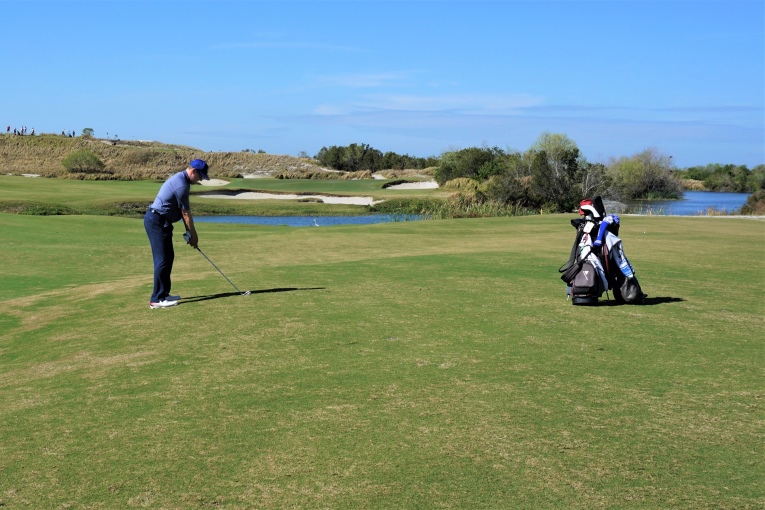
This gentleman’s approach to the 12th is made immeasurably more interesting by his awkward stance with the ball well above his feet. Any lover of links golf will relish the opportunity to make the necessary adjustments.
With improvements in agronomy, playing surfaces in all sorts of climates can be made firm and fast. Sometimes such surfaces can release the ball too quickly with the unfortunate and unintended result that balls don’t hang on slopes (i.e. all balls collect in the same low points). As seen above, these Bermuda fairways provide just enough stickiness for balls to rest on a variety of wonky locations across the rolling terrain. The importance of this can’t be overstated.
Regardless of approaching from Tampa or Orlando, one drives through small towns that offer an unadulterated view of central Florida and stand in contrast to the elegant resort. Overall there is a refreshing, genuine feel that is largely absent from either of the state’s glittering coastlines. Two clubhouses (one for the Black and one for Blue/Red) and the lodge complete the offering. All three structures were designed by Albert Alfonso, whose intent was to have the property’s evolution represented by the architecture. While the structures and golf are modern, only time-honored design principles have been applied throughout the resort.
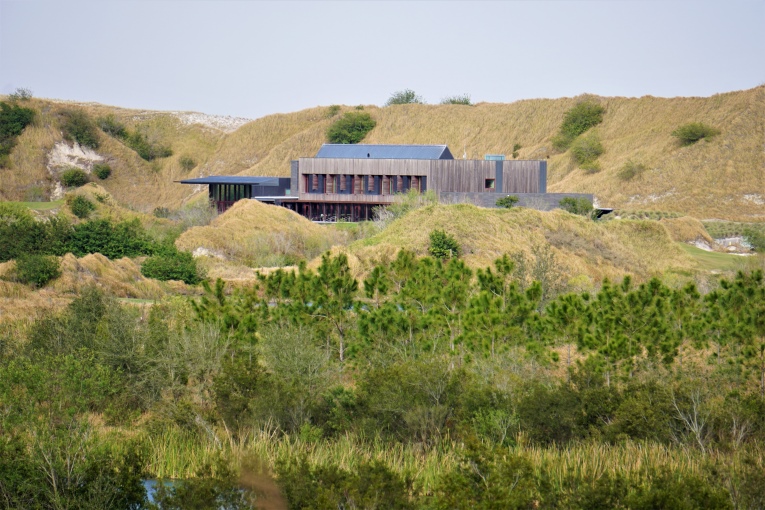
Golfers obtain only fleeting glimpses of the Red/Blue clubhouse during play as it is snuggled among the biggest dunes.
To commence play on the Blue, the golfer clambers up a 100 feet dune to the first tee, the high point of the property. All around there’s a pure golf landscape, something unheard of in Florida. It makes for a rousing start – and makes the golfer glad he came here.
Holes to Note
(Please note: the distances below are from Black tees, which yield a 6,700 yard course. The green tees stretch over 7,150 yards and would overwhelm most resort play).
Second hole, 530 yards; The author grew up playing a course with four par 5s that had one common feature: a cross bunker approximately sixty yards short of the green. Though those four bunkers were in the direct line of play, they had a muted impact. Too often, people routinely laid up to their favorite wedge distance (from 80 to 110 yards) and went about their business, unperturbed by those bunkers. Compare that to this scenario where cross hazards lie in wait from 210 yards to 115 yards from the green. The tiger going for the green isn’t worried about such features (just as he isn’t concerned with bunkers 60 yards short). However, the rest of us must deal with these physical and mental hazards. Pity, more architects don’t make the second shot as interesting.

Plenty of hazards are found within the Blue’s broad fairways. This dunescape was created 150 yards short of the 2nd green and golfers of all abilities enjoy a sense of accomplishment when they get past it in two.
Third hole, 370 yards; In architecture, the obvious runs the risk of becoming tedious. The author vividly remembers a round in 1999 at Doak’s newly opened Riverfront course outside of Williamsburg wherein the clear play was to the outside of the dogleg seventh. This became a revelatory moment to the author and it took a while to sink in but what a fine departure from the norm to play to the outside versus the inside of a dogleg. The same strategy occurs here: the worst trouble and a lumpy fairway dominate the left while an ‘Elysian Field’ extends long right.
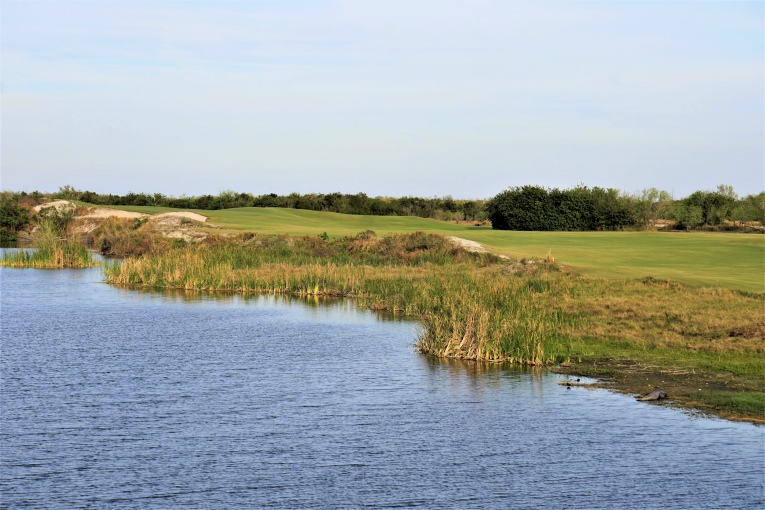
Despite the dramatic landscape, there is a good chance of playing multiple rounds on the Blue Course without losing a ball. That’s an odd statement to make with a lake down the left of this hole but, in fact, the play is to the outside of the dogleg.
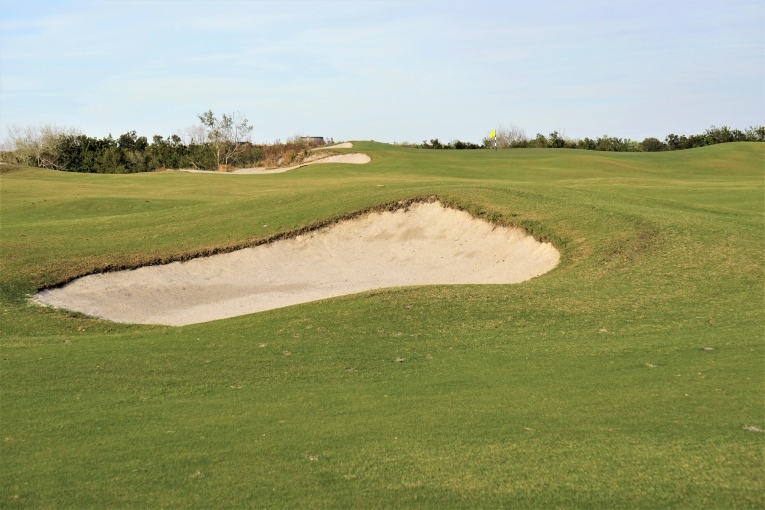
The angled green is best approached from the right center of the fairway but one must skirt this pesky solitary bunker 150 yards from the green.
Fourth hole, 415 yards; Bill Coore and Tom Doak share many more similarities than differences in their approach to architecture. Therefore, as previously mentioned, it is no surprise to learn that Coore also routed a hole over much of the same ground as today’s final version. Differences exist in length (Doak’s hole is longer) and green placement. Still, both architects saw the virtue of incorporating a long low ridgeline into the hole. As deans of the Second Golden Age, both architects embraced and drove the return to greens open in front that enabled ground options, especially on long, tough two shotters. That’s fine and dandy but they also know that rules are meant to be broken or how deadly dull things would be if all designs followed prescribed rules. At the fourth, a brute of a two shotter with a miniature cliff thirty yards short of the putting surface produces an uncompromising approach. A bunch of two shotters similar to this would overpower the golfer but as a standalone, it shines. As with many world-class holes, there’s the obvious (its heroic nature) and what’s learned (an ocean of short grass on the upper level surrounds the small putting surface and makes the hole immensely playable). The author places it in Doak’s eclectic best 18 holes – and it isn’t the only hole on the Blue that garners that accolade. The hole’s epic nature seems out of place in Florida, which makes us like it even more.

What a sight. A draw off the tee that hugs the bend in the fairway leaves the golfer the best angle into the green that’s on top of the ledge.
Sixth hole, 315 yards; A superb design, the sixth honors a time honored virtue validated at The Old Course of St. Andrews where greens run away from the player. When The Old Lady is at her most firm best, the farther a player drives the ball, the more awkward his approach, especially to front hole locations. At the sixth on The Old Course, for instance, you might be able to drive within 60-70 yards of the green with today’s equipment but technology doesn’t help you nearly as much for the next shot. Same here. What are the best tactics at this teaser? It depends on a multitude of factors (the day’s hole location, ground firmness, wind, etc.) but good for you on the day you figure it out. It’s a hole that can be played with any number of clubs and trajectories for the both the drive and approach.
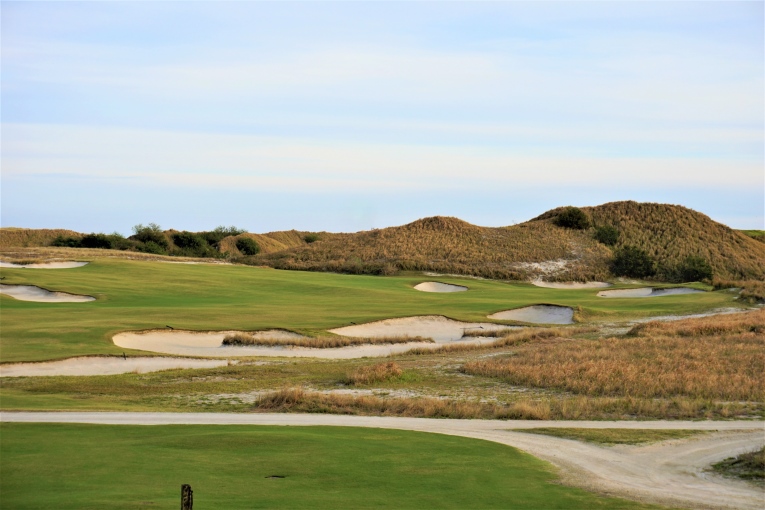
The 6th fairway flows right and ducks downhill setting the stage for a green that slopes from front to back.
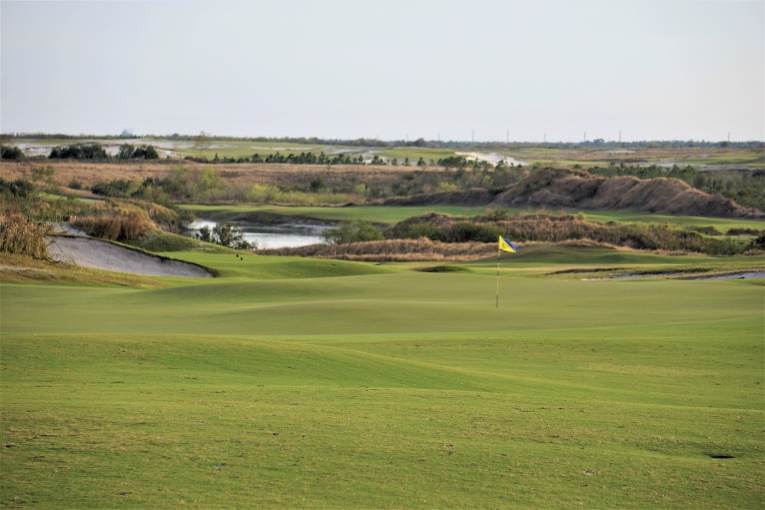
A big drive emphatically does NOT break the back of this short two shotter. In fact, it leaves this befuddling approach.

You might think back hole locations are easier but this view from behind shows how quickly things can go awry if the approach is a shade brave.
Seventh hole, 190 yards; GolfClubAtlas.com received several emails of indignation when this hole graced its cover after the course’s opening. One Golf Digest panelist described hitting the ‘perfect’ draw only to watch his ball trek along the right perimeter of the green, dive left down the slope, cross the green and tumble into the water. The expressed reservation that a draw was, perhaps, not the correct shape shot was met with silence as indeed a fade can be the golfer’s friend to neuter the green’s right to left tilt. As much as anything, the story speaks well as to the firmness of the playing conditions. While most Doak holes provide options on how to approach the green, this one is less relenting. However, the green is the second largest on the course at 42 paces deep and provides an ample target for the downhill shot. It surely occasions one of the two or three nerviest moments during the round and tidy play here is immensely satisfying.
Eighth hole, 435 yards; There are plenty of standout holes among Streamsong’s 54 and this is among the author’s top ten. Why? Because it represents positional golf of a very high order with much to be gained by proper placement of each shot. On big-boned courses, too often the drive doesn’t matter as much as it once did; the golfer is given the green light to give the ball a great thump with little consequence. Not here, there’s a well-located centerline bunker to confound the player and it makes accurate driving essential to gain optimal access to the angled green. Two ponds, especially the one left, insert themselves into the mix should the tee ball be farther afield. Doak states that the best feedback he has received on the course is from none other than Kyle Harris: ‘What Kyle noticed (that I did think about in building the course) is how when you take the conservative line off the tee, the tilt of the ground usually shunts you over further off line and makes the next shot much harder. That’s true at holes 2, 4, 6, 8, 9, 11, 13, and 15. But the guys who play the Blue once or twice think it’s an easy driving course and the greens are too severe, because they are approaching from the wrong angle.’
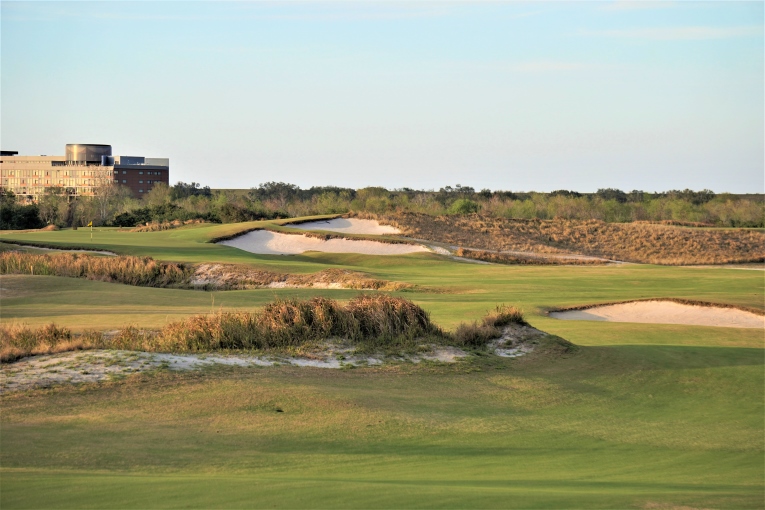
A reward certainly awaits those willing to go left of the central bunker off the tee as two fierce greenside bunkers and the slopes of their shoulders make an approach from the right problematic.
Ninth hole, 540 yards; If the resort had only 18 holes, perhaps, golf would never have ventured into this portion of the property. Indeed, some players opine that the ninth, tenth, and eleventh holes don’t quite feel like they belong with the rest of the course. Given that they lie on a mostly open plain and given the Blue’s sensory experience, the author considers the toned down visuals at nine, ten and eleven as an important quiet moment. This interlude allows the golfer to appreciate better the dazzling features found elsewhere. Put another way, consistently loud music fails to hold the listener’s attention versus a broader range of melodic movements.

The gorgeous tee shot at nine may not be the time to be brave but eventually, you’ll want to approach the angled green from the right.
Tenth hole, 160 yards; An underestimated hole, Scott Wilson, the Director of Golf, notes that the tenth might have changed the most since the course opened. Specifically, he notes the increase in bunker depth by more than a foot to the front left and right ones. That raises the question: why have those two bunkers received so much play? From the tee, the long right front bunker visually suggests a green flowing from front left to back right but the putting surface is in fact angled front right to back left. These confusing optics are such that many tee balls that look good in the air don’t find the green. It is one of the day’s more elusive shots and a distinct advantage falls to one who has confronted it before.
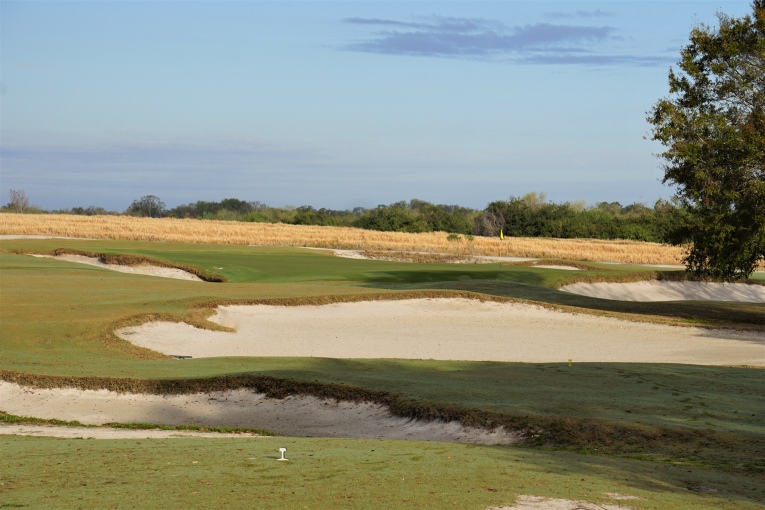
The shadow from a tree informs the golfer that the 10th is indeed in a different environment from much of the course. One thing to note is that there isn’t a single palm tree on the property. Instead, Live Oaks and Carolina Willows help lend the course a timeless look.
Eleventh hole, 455 yards; Better than either the Red or Black, the Blue features rumpled fairways into which solitary central bunkers have been cut. Prime examples are the third, eighth and here at the eleventh. For the author, these bunkers help make the Blue the most engaging driving test of the three courses as it is the best of all worlds: fairways broad enough to allow the crush of resort play to get around in a comfortable time while the tiger has much to think about – and gain – should he take on the varied challenges. Here, if one can skirt past the central bunker, he is left with a shot sadly absent in American golf: a poorly defined approach to a bunkerless green. It might be the author’s single favorite shot of the day. While the flag is visible, there’s nothing to aid depth perception or to suggest how best to tackle the shot. A return of eminently photograph-able shaggy bunkers in the 1990s made Americans lazy as to how they dissect a course and process information. Why? Because everything was obvious – avoid the big, beautiful bunkers and all will be well. This hole is the antithesis of that trend and the absence of framing is wonderful.

The flag stands proudly in a sea of grass. The sands-cape in the far distance is more than 100 yards beyond the green.
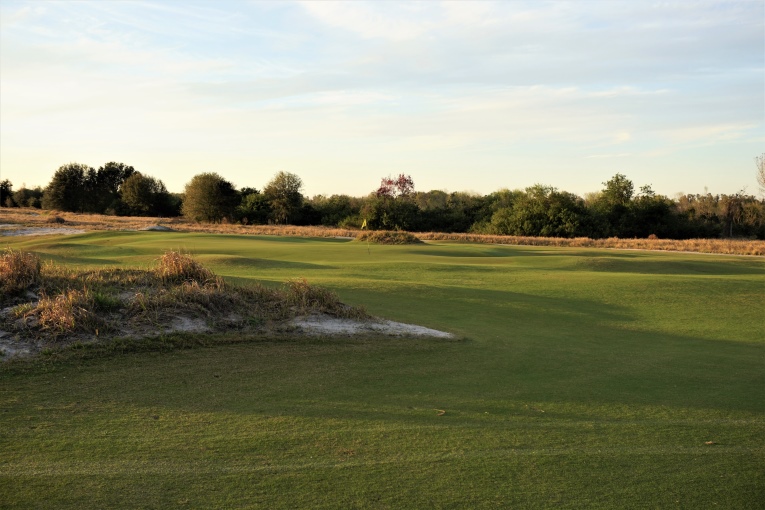
… from the left, the green is at grade to its immediate surrounds. The irony is that the approach is more difficult to gauge because of the lack of hazards. It’s a neat design trick that more architects should employ.
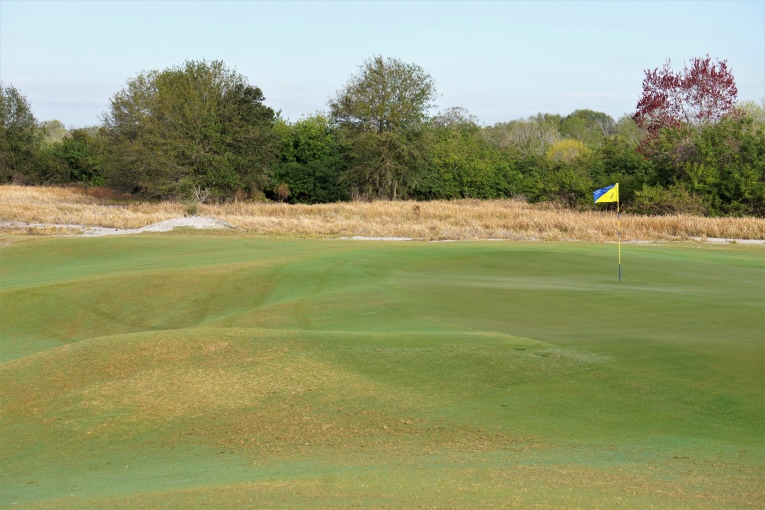
Just because there are no greenside bunkers doesn’t mean the player can’t find himself with a very difficult recovery. Here’s a diabolical back hole location with a four foot falloff close by.
Twelfth hole, 390 yards; The Blue alternates between expansive views (first tee, second tee, seventeenth tee) and holes cocooned in their own shallow valleys (e.g. the fourth, seventh, eighth, and here). This is a particularly handsome hole, made more graceful by the land movements in the fairway and through the green.
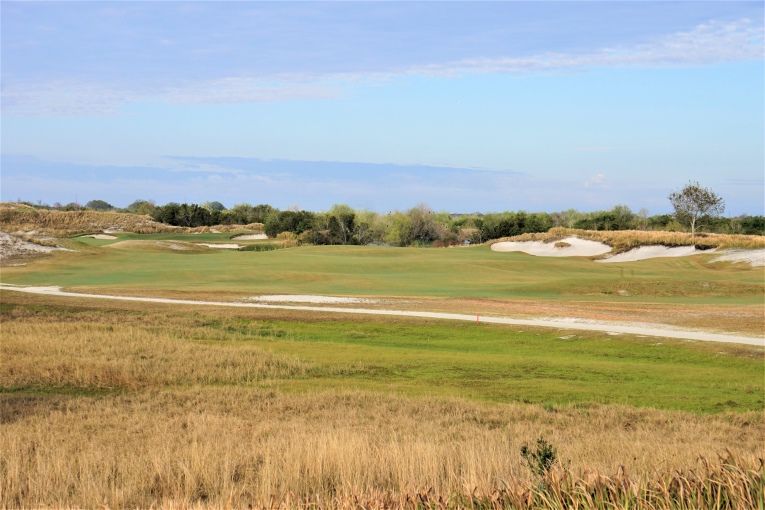
The author despises emerald green fairways that pierce the landscape and appear detached from the environment. Streamsong aces the presentation: note how the prepared playing surfaces meld into the surrounds. Generally, golfers have to travel to Australia to find course preparation of such high caliber.

Life comes with few guarantees but one is that a sub 400 yard Doak hole will be defended at the green.

The distant trees say something different but otherwise, the bold contours of the putting surface remind the author of links like Machrihanish and Ballybunion.
Thirteenth hole, 295 yards; Some of the most evil holes on a Doak course tend to be short two shotters. Examples include the second at St. Andrews Beach, seventh at Tara Iti, and here. Par isn’t guaranteed and the good player is more likely to harm his score on these holes than most others. Trouble begins when the driver is selected. After witnessing nearly two decades of carnage, the author has become far more timid in his approach. At Streamsong, the tiger might well blow a driver past the bunker 65 yards shy of the green and reach the long narrow putting surface. Yet, if the drive drifts a shade left it likely tumbles into the course’s deepest greenside bunker. Why invite such consternation into your life? Play a hybrid left and be content with a wedge approach over the bunker to the heart of the green. Over a playing season, that strategy will surely yield the better result. Just be aware that the middle is the green’s high point, so short of forward hole locations and a bit past deep ones will leave the desired uphill birdie putt.
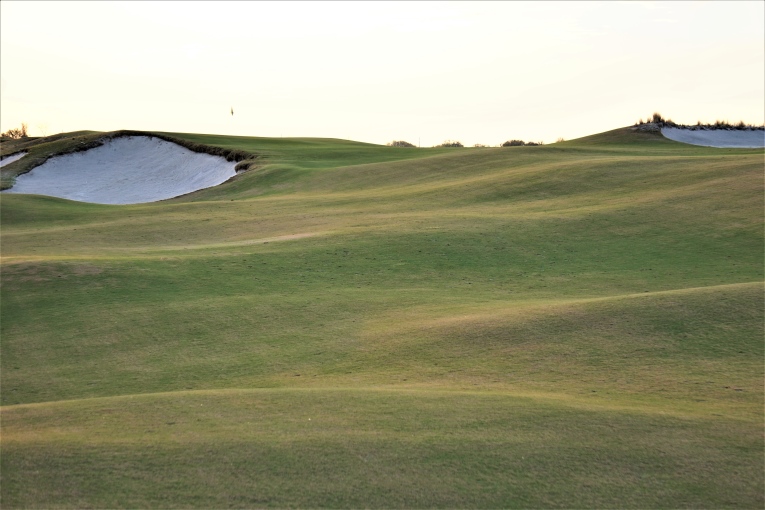
Here is the 85 yard approach from the left center of the fairway. Perhaps your younger opponent has carried the right bunker and run onto the green? Don’t count on it.
Fourteenth hole, 510 yards; Perfectly conceived angles make this hole a star and it garnered the ultimate complement when Kyle Harris commented that this hole had grown on him the most over the past seven years. Such a statement speaks volumes for a hole’s subtle playing qualities. With oodles of money to spend, some architects feel compelled to deliver a product that screams for attention. That’s a shame because contrivances, like fads, come and go. Strategy endures and here the smallest green on the Blue at 4,450 square feet delivers. Good players can have a slash in two but if they finish above the undersized target, odds for a birdie dim given the green’s steep back to front incline. As an aside, rarely is a hole with a small green among a course’s least distinguished holes; Having one or two greens significantly smaller than the rest is a laudable attribute on any design.
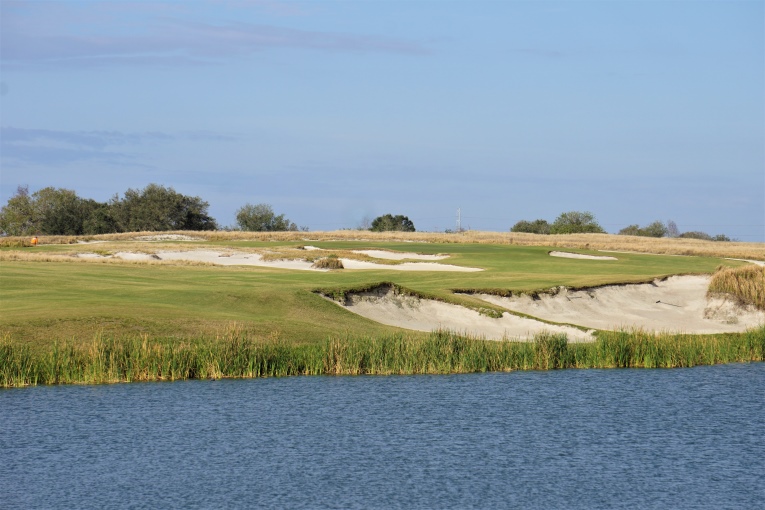
The golfer has to contend with the worst trouble (deep bunkers, water) to gain the best access to the green in two.
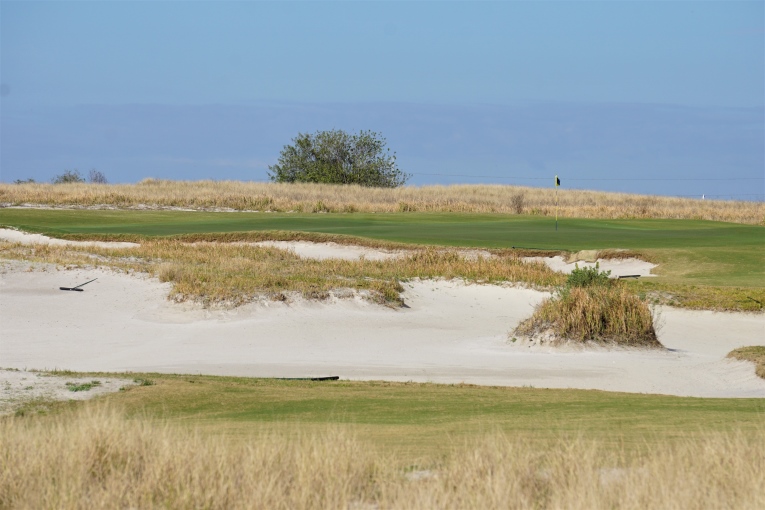
The sand is eye-catching as it extends over 100 yards from the front left of the green but the real menace is the small, pitched putting surface. Wherever you are in three, you best be below the hole.
Fifteenth hole, 400 yards; After the bunkerless approach to the eleventh, a series of sand-scapes dominate. Five bunkers surround the twelfth green, a profoundly dangerous pit fronts the thirteenth green, and deep fairway bunkers and a large sandy swath linger at fourteen. Same applies at the uphill sixteenth and mammoth seventeenth. So, what does the fifteenth feature? You guessed it. A rolling green floating in a sea of short grass, creating a fine change of pace. Doak notes that Blue fifteen ‘… is the one hole I found on the map that was identical with a hole Bill had found.’ A pair of Spectacle bunkers are pulled seventy yards off the putting surface to create visibility and depth perception issues. Be it into the wind or downwind, the hole plays equally well. The huge fairway is shared with fourteen and the acre of short grass beyond the Spectacles makes this hole all about the ground. In fact, Doak’s crew did little to this fairway as nature kindly provided the humps and hollows. Of the three courses, the least construction was required for the Blue and for the author, that is tantamount to saying that the Blue is situated on the best property.

Peek-a-boo. Generally you can see the flag but the putting surface itself is a different matter thanks to this central hazard well short of the green.
Sixteenth hole, 215 yards; One shotters are a handy way to ascend slopes. The more abrupt the slope, the shorter the hole. In this case, the gradual 6% rise lent itself to a lengthy one shotter. Handsome bunkers clawed into the upslope give it a Sandbelt feel. A single bunker left fools as it is thirty paces shy of the putting surfaces. While plenty of folks dislike uphill holes because they preclude visual appreciation of their shots, this slope is gradual enough that the player delights to see his ball dance from left to right across the canted green.

A tee ball that flies over the right edge of the short left bunker is shunted off the hillside onto the open green. It’s a wonderfully slow shot to watch unfold.
Seventeenth hole, 575 yards; Is there such a thing as a bad set of cross bunkers? We think not but many golfers don’t confront them enough to development an educated opinion. Such a shame since they are both handsome and a strategic additions to a design. Success hinges on their placement and the four here cut into the face of a natural ridge are particularly well-situated. They fall 440 yards from the black tees and if a well hit drive doesn’t find the fairway or if there’s a head wind, clearing them in two becomes quite the proposition. The golfer who does so enjoys an approach shot 60 yards shorter in length than his friend who layed up. Capped off by a fascinating green with a thumb print impression front left, this has to be among Doak’s all-time finest three shotters.
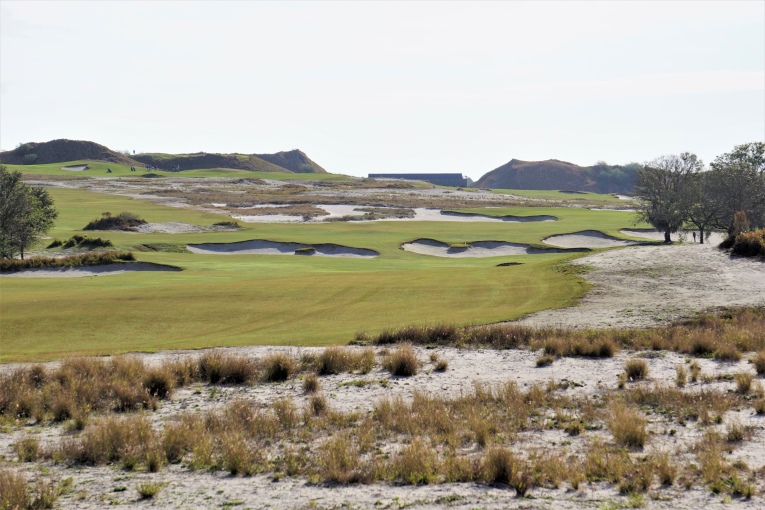
Standing near this spot, the golfer has only two holes to play but nearly 1,000 yards to cover. Congratulations to the resort for its diligent tree pruning that has both preserved and enhanced the hole’s scale.
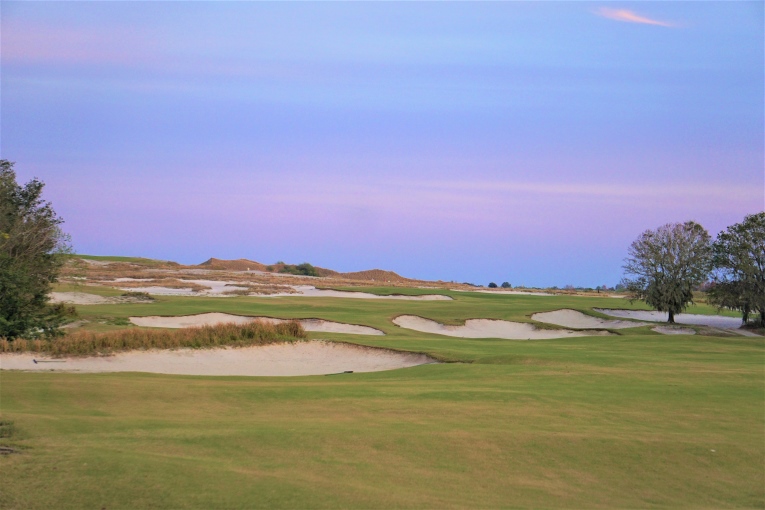
Adam Lawrence considers this one of the world’s great three shot holes. The late evening sky accentuates its grandeur.
Eighteenth hole, 455 yards; The author loves Home holes like those at Prestwick and St. Andrews not because they are easy but because they constitute half pars that tend to produce varied scores. Same here, except it’s a 4 1/2 par. In The Confidential Guide – Volume 2, I wrote that these three holes comprised my favorite finish of any Doak course. Having since seen Dismal River Red, it is a close call but the Blue’s conclusion might still be Doak’s best. Other famed closing stretches in the state (TPC Stadium, Doral, Bay Hill) rely on water which further highlights how much more praiseworthy the golf at Streamsong is than elsewhere in the state.
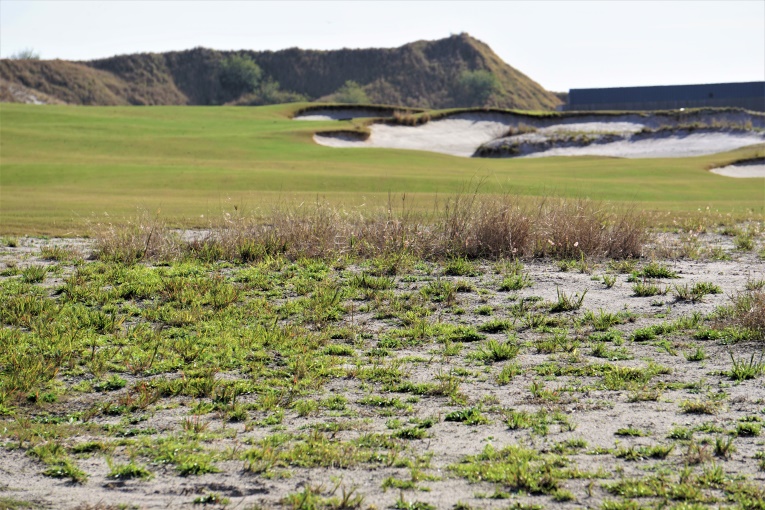
An easy mistake for most five star resorts is to present a too manicured/perfect course. That’s what guests are conditioned to expect, so why not give it to them? Blue embraces its roots in central, rustic Florida because Streamsong is smart and doesn’t pander to what is wrong with American golf.

A nest of central bunkers occupy the space from 70 yards to 135 yards from the green and the day’s final full shot is a thrilling one that must carry them. Sometimes a bullet three wood is what’s required and seeing the ball interact with the ground and drift right toward a very soft, semi-punchbowl green will long linger in the mind. The manner in which the architecture puts the ground game on a pedestal makes for a first rate conclusion.
At this point in Doak’s career, the only knock on his work is that he builds greens that are too ‘exuberant.’ At Streamsong, plenty prefer the Red, sniffing that ‘the Blue greens are over the top.’ Of course, these same people love The Old Course at St. Andrews and a host of other courses with wicked green contouring … so the author tends to think it is more a cliché than anything fact-based. Indeed, the large greens on the Blue seem to offer an inordinate number of fun and varied hole locations, making it an odd set upon which to vent ire. Plus, there are plenty of gathering features around many of the greens like the exquisite sixteenth and soft punchbowl Home green that should be applauded, not bemoaned. The four Blue greens that draw the most criticism are five thru seven and twelve. The fifth green is 74 yards long so there are clearly ways to avoid its most controversial feature which is its back right bowl (on the rare occasions when the hole is located there, hole-in-ones occur with some frequency and the people that accomplish that feat become big fans of the design!). The sixth falls away and most American simply don’t know how to handle a putting surface that doesn’t act as ‘a catch’s mitt.’ Like the sixth, the twelfth green defends the integrity of a short-ish two shotter. Finally, the seventh: if a player is top right and the hole is lower back left, there is no consoling him. It’s unusual for someone with imagination not to find a way to two putt a Doak green (even if that means putting off it for a bit), so perhaps the envelope was pushed too far in this instance, especially given the penal nature of the hole. Still, the thing with Doak is that he continues to take chances later in his career – very few architects can claim the same. Besides, a couple of features that wildly irritate are a good – not bad – thing.
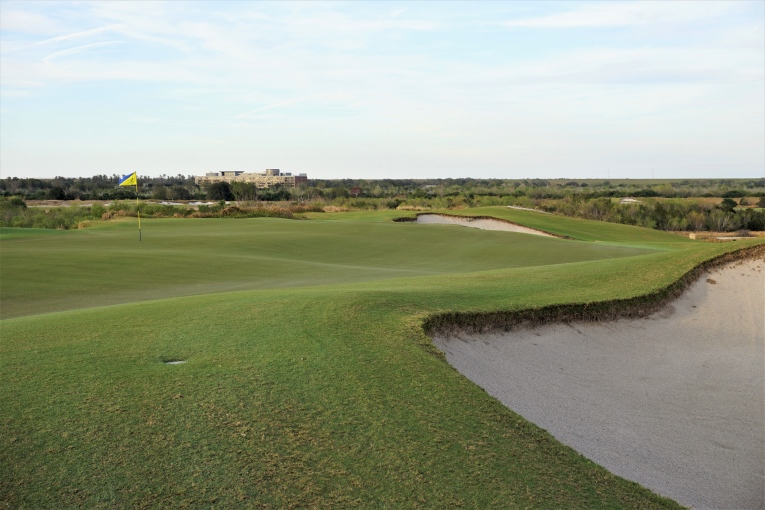
This three foot bowl in the back right of the 5th green is nails on a chalk board to some. Given that the green is a staggering 74 paces deep, it is easy to avoid, so why all the ruckus?
So, which is your favorite at Streamsong? Only one way to find out! The author’s tipping point for the Blue is how it constantly changes its requests. As I stated in The Confidential Guide, ‘One moment you have a bump and run into the short 6th and the next, a demanding forced carry. An open green like the 11th (there isn’t a bunker within 200 yards) that runs away is followed by a two tiered green ringed with trouble at the 12th.’ A switch back hole like the fourteenth requires a fade off the tee and a draw approach. The varied green features – table top fifth, front to back sixth, high right to low left seventh, back left to front right eighth – are exemplary. The golfer continually needs to adjust to what is being asked of him. Not only are the individual holes compelling but the shifting demands create a rhythm that borders on the sublime.
Compelling cases can be made for the Red and the Black. That’s what happens when talented architects are given the required space in which to express their art. The Red is replete with 1/2 par holes in differing directions (e.g. the first, fourth, seventh, ninth, twelfth, fifteenth, and sixteenth) and the Black features some of the largest putting surfaces in the country.
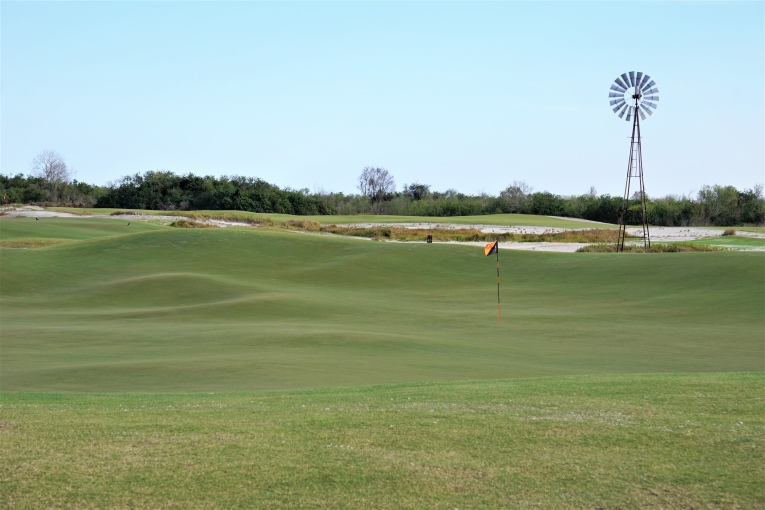
The Black Course is removed from the Red and the Blue and enjoys its own voice. One of its unique attributes is the size of its greens, including this monstrous Punchbowl that caps off the 9th hole. Alex Aloisio, the Greenkeeper for the Black, has the surfaces hard and running so the thrill of such architecture really shines.
The Streamsong Resort is a runaway success, both environmentally and economically. It teems with people from around the world but the massive property dwarfs them. One of the hallmarks of a great course is that you would be chuffed to stroll the property without clubs. These photographs were acquired on such a trek when two herds of deer were encountered and glimpses of the hotel with its ever-changing mood were afforded in the fading light. The wind flowing over the hued native grasses and rolling fairways tinged with yellow helped complete an exceptional outdoor experience. The commotion and excavation of phosphate mining is long gone, instead, there’s a profound peacefulness to the property that only highlights what a great steward to land man can be. Congratulations to Mosaic for creating something that gets people outside and enjoying a part of Florida that few would otherwise get to experience. Golfers everywhere win.

Wonder what one of the former dinosaurs might make of the sight of the lodge at sunset? He might ruminate “friend or foe”!






